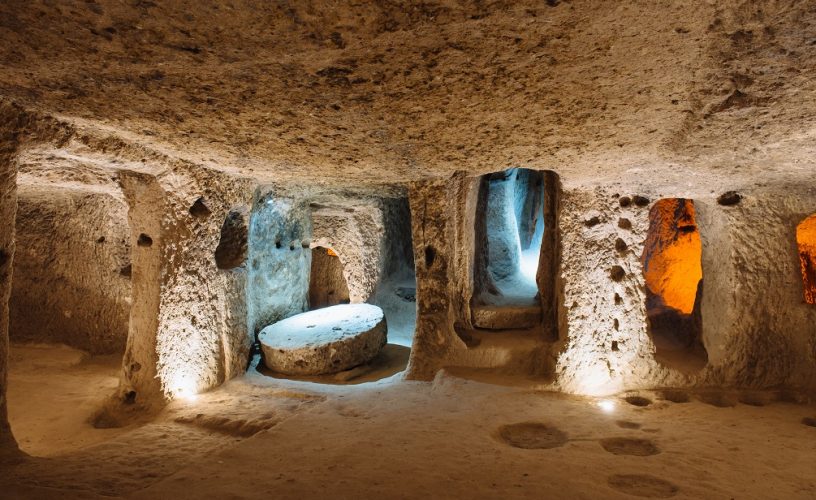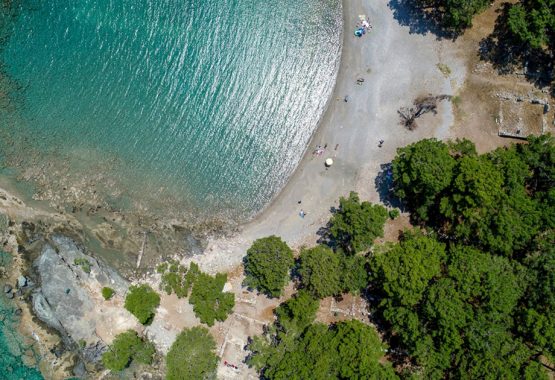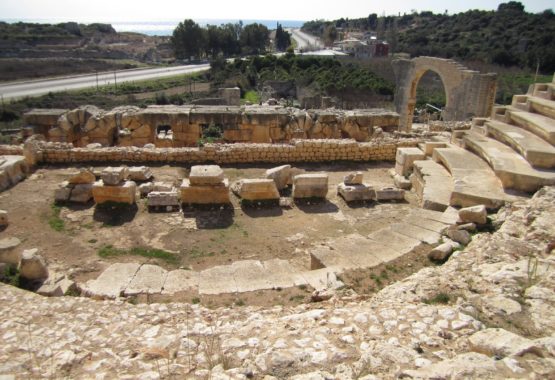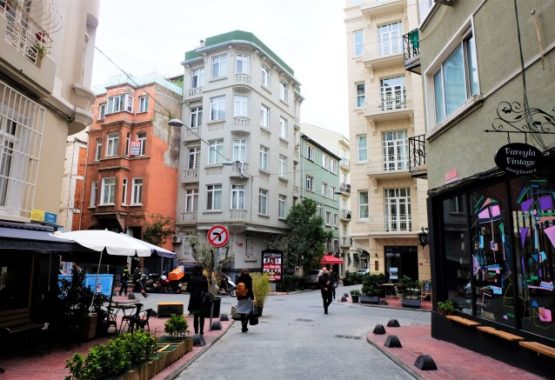One of the characteristics of Cappadocia is having plenty of underground cities. It’s known that there are more than a hundred of underground settlements in the region and many of them are not open for visits. The underground cities, which are guessed to be used since the Bronze Age, used to be a settlement mostly in Byzantine period, doubtless. In this period, increasing invasions forced local residents to build underground cities for protection and religious purposes.
UNDERGROUND CITYS
Certainly the most interesting features of the Cappadocia area are the underground cities founded within. Until now even that have been determined about 40 underground cities just six of these have been opened for visit. Nobody can know how many underground cities there are in the Cappadocia area. Some say that there is one for every village and settlement in the region but certainly not all of the sites can be described as cities. Well known underground cities of Cappadocia area are Tatlarin Underground city, Derinkuyu Underground City, Ozkonak Underground City, Mazi Village Underground City, Saratlı kırkgöz underground city, Kaymakli Underground City and Gaziemir Underground City
The first inhabitants of Cappadocia area have opened deep cavities within the volcanic rocks due to escape from the attacks of the wild animals and hard winter conditions and then they have enlarged these cavities according to their daily needs, they opened new cavities and created the underground cities connecting these cavities with tunnel and labyrinths. Later the underground cities were the place of the hiding of the first Christians who escaped from the persecution of the Roman soldiers and were enlarged to able when were necessary an entire city to live and every kind of fixture necessary for the living of the people has been attached. When there wasn’t any danger the people living on the ground in case of the danger have hidden in the underground cities. For this reason all the homes at that time were connected to the underground cities with a tunnel.
In all of the underground cities there are ventilation chimneys reaching place by place to a depth of 80 and until the underground waters. These chimneys were opened due to meet the need of both the ventilation and water.
The oldest written source about underground cities is the Anabasis named book of Xenophon (Written around B.C. 4). In the book is mentioned that the people living in Anatolia have caved their houses underground and that the houses are dependent to each other with holes: “The houses were built underground; the entry were like wells but they broadened out under down. There were tunnels dug in the ground for the animals while the men went down by stairs. Inside the houses there were goats, sheep, cows and poultry with their young…”
One of Cappadocia’s most famous underground cities is Derinkuyu, which was built during the Byzantine era when its inhabitants used it to protect themselves from Muslim Arabs during the Arab-Byzantine Wars between 780 and 1180. The multi level city was composed of many passages and caves used for various purposes, the city lies around 60 meters under the ground and was able to shelter around 20,000 people including their livestock and food. Certainly the largest underground city in Cappadocia (and of course in all of Turkey), Derinkuyu was opened to visitors in 1969 with only half of the city available for viewing.
The underground city at Derinkuyu has all the usual amenities found in other underground complexes across Cappadocia, such as wine and oil presses, stables, cellars, storage rooms, refectories, and chapels. Unique to the Derinkuyu undergorund city complex and located on the second floor is a spacious room with a barrel vaulted ceiling. It has been reported that this room was used as a religious school and the rooms to the left were studies. Between the third and fourth levels is a vertical staircase. This passage way leads to a cruciform church on the lowest level.
Kaymakli underground city is built under the hill known as the castle of Kaymakli and was opened to visitors in 1964. The people of Kaymakli (Enegup in Greek) village have establish their houses around almost one hundred tunnels of the underground city. The inhabitants of the region still use the most appropriate places in the tunnels as cellars, storage areas and stables, which they access through their courtyards. The Kaymakli Underground City has low, narrow and sloping passages. While the underground city consists of 8 floors below ground, only 4 of them are open to the public today, in which the spaces are organized around ventilation shafts.
Kaymakli underground city is on the Ihlara valley strip and 20 km far from Nevsehir province. Old name was Enegup. Kaymakli people were built their homes around the underground city tunnels for security reason. Kaymakli underground city has 8 storey and 5000 peoples can live in it, 4 storey is open yet. The deepest point of the visit is under 20 meters. Kaymakli was built in around a main ventilation chimney. Ventilation system is so successful that not feel a problem even the fourth floor. Has all housing conditions for crowdy group temporary housing. There are rooms and halls connecting to each other with narrow corridor, wine tanks, water cistern, kitchen and food stores, ventilation chimneys, water wells, churches and large lock stones for any danger from out.
First floor is used for animal shelter. Usually first floor of underground cities uses as animal shelter for difficult to take animals the downstairs. Second floor has a church with two abscissa. There are baptism stones front of the abscissas and a cemetery for important persons near the church. Moreover this floor has a big lock stone for close passing. Lock stones are circular and has a hole in the middle, 55-60 cm thick, 170-175 cm long and 200-500 kg weight. Lock stones shut down the entrance by ronunding vertical position in the special section at the entrance of the tunnel. There are labyrinths, hasn’t exit tunnels and so many ambushes and secret passages for escape. Third floor is larger ans broad than the others and used as a food store, has so many sections for keep back wine, wheat and flour. Moreover there are winnery and kitchen. There are big food stores in the fourth floor. This is show that underground city people has a regularly economy living.
Ozkonak town of Nevsehir city which 14 km northeast of Avanos is located on the northern slopes of the Idis Mountain, there are supernormal underground structure of Ozkonak underground city. There is only a single main passage, and the whole city is built along it by cut volcanic granite. Ozkonak underground city has long, narrow connections, about 5cm in diameter, connect the different levels and naighbouring chambers. They were used for communication between the levels and for ventilation. There are ten rooms, four big salloon, eight water well, four tombs, ventilation system, winery and closeable doors via circle stone like millstone for security reason. Additionally there are so many ambushes in the long narrow tunnels for to mislead enemy in the Ozkonak underground city.
Common among the underground cities are huge millstone doors. The millstones were rolled into narrow sections of the passage and wedged from behind. Here at Ozkonak, they have a special feature in front of the millstone doors on the ceiling are small holes. They are connected with a tunnel above, and were used to pour hot oil on the enemy or to spear them.
TATLARIN-ACIGOL UNDERGROUND CITY
The underground city at Tatlarin is located on a nearby hill called The Castle by the locals. Two different levels of the city can be visited. There are several churches, and extremely rare is the presence of toilets. There is only one other place in Cappadocia with this kind of toilets, thats Guzelyurt. Remarkable is the size of the chambers and the high number of food depots. There are theories, that this was no typical village, but a garrison or a monastic complex.
Nearby, at the slope of the hill is the Tatlarin Underground Church. Allthough part of the two nave church has collapsed, there are many murals to see. Painted on dark grey background are figures in purple, red and mustard. The scenes of episodes from the bible are separated from each other by dividers. They show Mother Mary with Jesus, Archangels Michael and Gabriel, Anastasis, Entry into Jerusalem, the Crucifixion, and the Transfiguration. There are also portraits of nine Saints. Secular pictures show Constantine the Great, Helena, and the donors of the church.
MAZI UNDERGROUND CITY
The ancient name of the city was known as Mataza. The presence of the city dates back to as early as the Roman period. The city contains tombs dating back to the early Roman period and also contains aspects of the Byzantium period.
Mazi is carved to the west of the village perpendicular to the valley slope. It contained four different access points for entrance and exit to the city which all lead to a central hall. The main entrance to the city is made of millstone in which a stone could be rolled over and used to cover the entrance.The architecture includes steep tunnels networking between corridors. Within the city, areas were provided to serve as barns, with each area designated for different specialties. The space inside the city also contained a winery between the areas served as barns. In order for the winery to obtain grapes, there was a chimney which led to the surface and allowed grapes to fall down into. Additionally, the city contains a church which can be accessed via a short corridor.
OZLUCE UNDERGROUND CITY
This underground settlement which is located in the centre of the village of Ozluce, the old name of which was Zile, is on the Nevsehir-Derinkuyu road, 6 km south of the town of Kaymakli.
Ozluce Underground settlement is different from the others in terms of its geological formation and architectural features. The underground settlement has tufa of different colors. There is only one floor in this underground settlement which has not been completely opened; however, it covers a very large area.
At the entrance is a place with two intertwining arches made of basalt. Access to the main tufa stone can be gained through a 15 m long passage, made of rubble stone. The stone places, which lead to the underground settlement, are more recent than the rock hollowed places that form the underground settlement. At the end of this passage there is a millstone door which is made of hard granite and is 1.75 m in diameter.
Being the largest area in the underground settlement, the main space at the entrance consists of two parts. To the right of the main space are storage rooms, and to the left are living areas. On the sides of the long corridors are cell-like rooms and on the floor are traps.






